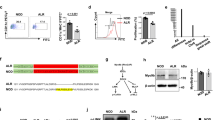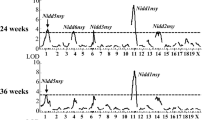Abstract
The 40 Mb T1D susceptibility locus Iddm26 was mapped to chromosome 2 through linkage analysis of a conditioned cross-intercross between the diabetes-prone BBDP and the diabetes-resistant ACI.BBDP-Iddm1,Iddm2 (ACI.1u.Lyp). It is flanked by Iddm32 and Iddm33, which control the kinetics of disease progression. To fine-map Iddm26 and characterize immune phenotypes controlled by this locus, several congenic sublines were generated carrying smaller, overlapping intervals spanning Iddm26 and fragments of Iddm32 and 33. Analysis of disease susceptibility, age of disease onset, and immune phenotypes in these sublines identified subloci regulating these different parameters. Two ACI.1u.Lyp-derived subloci, Iddm26.1 and Iddm26.2, imparted significant protection from diabetes, decreasing the cumulative incidence by as much as 57% and 28%, respectively. Iddm26.2, which overlaps with the human PTPN22 locus, only affected disease susceptibility, whereas Iddm26.1 also significantly affected disease kinetics, delaying T1D onset by more than 10 days compared with the parental BBDP strain. These Iddm26 subloci also regulated various immune phenotypes, including the proportion of splenic macrophages by Iddm26.1, and the proportion of activated T-cells in secondary lymphoid organs by Iddm26.2. The analysis of Iddm26 congenic animals in two different SPF facilities demonstrated that the influence of this locus on T1D is environment-dependent.
This is a preview of subscription content, access via your institution
Access options
Subscribe to this journal
Receive 6 digital issues and online access to articles
$119.00 per year
only $19.83 per issue
Buy this article
- Purchase on Springer Link
- Instant access to full article PDF
Prices may be subject to local taxes which are calculated during checkout











Similar content being viewed by others
References
Wallis RH, Wang K, Marandi L, Hsieh E, Ning T, Chao GY et al. Type 1 diabetes in the BB rat: a polygenic disease. Diabetes 2009; 58: 1007–1017.
Klaff LS, Koike G, Jiang J, Wang Y, Bieg S, Pettersson A et al. BB rat diabetes susceptibility and body weight regulation genes colocalize on chromosome 2. Mamm Genome 1999; 10: 883–887.
Bottazzo GF, Dean BM, McNally JM, MacKay EH, Swift PG, Gamble DR . In situ characterization of autoimmune phenomena and expression of HLA molecules in the pancreas in diabetic insulitis. N Engl J Med 1985; 313: 353–360.
Gepts W . Pathologic anatomy of the pancreas in juvenile diabetes mellitus. Diabetes 1965; 14: 619–633.
Liston A, Enders A, Siggs OM . Unravelling the association of partial T-cell immunodeficiency and immune dysregulation. Nat Rev Immunol 2008; 8: 545–558.
MacMurray AJ, Moralejo DH, Kwitek AE, Rutledge EA, Van Yserloo B, Gohlke P et al. Lymphopenia in the BB rat model of type 1 diabetes is due to a mutation in a novel immune-associated nucleotide (Ian)-related gene. Genome Res 2002; 12: 1029–1039.
Ramanathan S, Norwich K, Poussier P . Antigen activation rescues recent thymic emigrants from programmed cell death in the BB rat. J Immunol 1998; 160: 5757–5764.
Zadeh HH, Greiner DL, Wu DY, Tausche F, Goldschneider I . Abnormalities in the export and fate of recent thymic emigrants in diabetes-prone BB/W rats. Autoimmunity 1996; 24: 35–46.
Poussier P, Ning T, Murphy T, Dabrowski D, Ramanathan S . Impaired post-thymic development of regulatory CD4+25+ T cells contributes to diabetes pathogenesis in BB rats. J Immunol 2005; 174: 4081–4089.
Hanenberg H, Kolb-Bachofen V, Kantwerk-Funke G, Kolb H . Macrophage infiltration precedes and is a prerequisite for lymphocytic insulitis in pancreatic islets of pre-diabetic BB rats. Diabetologia 1989; 32: 126–134.
Kolb-Bachofen V, Schraermeyer U, Hoppe T, Hanenberg H, Kolb H . Diabetes manifestation in BB rats is preceded by pan-pancreatic presence of activated inflammatory macrophages. Pancreas 1992; 7: 578–584.
Lee KU, Amano K, Yoon JW . Evidence for initial involvement of macrophage in development of insulitis in NOD mice. Diabetes 1988; 37: 989–991.
Like AA, Guberski DL, Butler L . Influence of environmental viral agents on frequency and tempo of diabetes mellitus in BB/Wor rats. Diabetes 1991; 40: 259–262.
Dyrberg T, Schwimmbeck PL, Oldstone MB . Inhibition of diabetes in BB rats by virus infection. J Clin Invest 1988; 81: 928–931.
Sadelain MW, Qin HY, Sumoski W, Parfrey N, Singh B, Rabinovitch A . Prevention of diabetes in the BB rat by early immunotherapy using Freund's adjuvant. J Autoimmun 1990; 3: 671–680.
Sobel DO, Goyal D, Ahvazi B, Yoon JW, Chung YH, Bagg A et al. Low dose poly I:C prevents diabetes in the diabetes prone BB rat. J Autoimmun 1998; 11: 343–352.
Scott FW, Rowsell P, Wang GS, Burghardt K, Kolb H, Flohe S . Oral exposure to diabetes-promoting food or immunomodulators in neonates alters gut cytokines and diabetes. Diabetes 2002; 51: 73–78.
Sobel DO, Ewel CH, Zeligs B, Abbassi V, Rossio J, Bellanti JA . Poly I:C induction of alpha-interferon in the diabetes-prone BB and normal Wistar rats. Dose-response relationships. Diabetes 1994; 43: 518–522.
Hillhouse EE, Collin R, Chabot-Roy G, Guyon MJ, Tessier N, Boulay M et al. Nearby construction impedes the progression to overt autoimmune diabetes in NOD mice. J Diabetes Res 2013; 2013: 620313.
Tarcic N, Ovadia H, Weiss DW, Weidenfeld J . Restraint stress-induced thymic involution and cell apoptosis are dependent on endogenous glucocorticoids. J Neuroimmunol 1998; 82: 40–46.
Teshima H, Sogawa H, Kihara H, Nakagawa T . Influence of stress on the maturity of T-cells. Life Sci 1991; 49: 1571–1581.
Hori T, Fukuda M, Suzuki H, Yano S, Ono T . SART stress effects on lymphocytes in the thymus and spleen of normal, adrenalectomized, and sympathectomized mice. Clin Immunol Immunopathol 1993; 68: 243–245.
Concordet JP, Ferry A . Physiological programmed cell death in thymocytes is induced by physical stress (exercise). Am J Physiol 1993; 265 (3 Pt 1): C626–C629.
Renga B, Migliorati M, Mencarelli A, Fiorucci S . Reciprocal regulation of the bile acid-activated receptor FXR and the interferon-gamma-STAT-1 pathway in macrophages. Biochim Biophys Acta 2009; 1792: 564–573.
Vavassori P, Mencarelli A, Renga B, Distrutti E, Fiorucci S . The bile acid receptor FXR is a modulator of intestinal innate immunity. J Immunol 2009; 183: 6251–6261.
Huang J, Liu T, Xu LG, Chen D, Zhai Z, Shu HB . SIKE is an IKK epsilon/TBK1-associated suppressor of TLR3- and virus-triggered IRF-3 activation pathways. EMBO J 2005; 24: 4018–4028.
Crespo P, Leon J . Ras proteins in the control of the cell cycle and cell differentiation. Cell Mol Life Sci 2000; 57: 1613–1636.
Oliveira JB, Bidere N, Niemela JE, Zheng L, Sakai K, Nix CP et al. NRAS mutation causes a human autoimmune lymphoproliferative syndrome. Proc Natl Acad Sci USA 2007; 104: 8953–8958.
Galli SJ, Kalesnikoff J, Grimbaldeston MA, Piliponsky AM, Williams CM, Tsai M . Mast cells as ‘tunable’ effector and immunoregulatory cells: recent advances. Annu Rev Immunol 2005; 23: 749–786.
Geoffrey R, Jia S, Kwitek AE, Woodliff J, Ghosh S, Lernmark A . A et al. Evidence of a functional role for mast cells in the development of type 1 diabetes mellitus in the BioBreeding rat. J Immunol 2006; 177: 7275–7286.
Tuller T, Atar S, Ruppin E, Gurevich M, Achiron A . Common and specific signatures of gene expression and protein-protein interactions in autoimmune diseases. Genes Immun 2013; 14: 67–82.
Bottini N, Musumeci L, Alonso A, Rahmouni S, Nika K, Rostamkhani M et al. A functional variant of lymphoid tyrosine phosphatase is associated with type I diabetes. Nat Genet 2004; 36: 337–338.
Begovich AB, Carlton VE, Honigberg LA, Schrodi SJ, Chokkalingam AP, Alexander HC et al. A missense single-nucleotide polymorphism in a gene encoding a protein tyrosine phosphatase (PTPN22) is associated with rheumatoid arthritis. Am J Hum Genet 2004; 75: 330–337.
Colle E, Fuks A, Poussier P, Edouard P, Guttmann RD . Polygenic nature of spontaneous diabetes in the rat. Permissive MHC haplotype and presence of the lymphopenic trait of the BB rat are not sufficient to produce susceptibility. Diabetes 1992; 41: 1617–1623.
Wallis RH, Wang K, Dabrowski D, Marandi L, Ning T, Hsieh E et al. A novel susceptibility locus on rat chromosome 8 affects spontaneous but not experimentally induced type 1 diabetes. Diabetes 2007; 56: 1731–1736.
Acknowledgements
We thank K Kathirkamathamby for providing us with mAbs used in the immune phenotyping analysis, and the Sunnybrook Comparative Research Facility and the OCI Animal Resource Centre for the care and maintenance of our animal colonies. This work was supported by grants from the Canadian Institutes of Health Research (64216 and MOP77713), Genome Canada (administered by Ontario Genomics Institute) and the Juvenile Diabetes Research Foundation (17-2011-520). JS was supported by studentships from the Canadian Institutes of Health Research and the Banting and Best Diabetes Centre.
Author information
Authors and Affiliations
Corresponding author
Ethics declarations
Competing interests
The authors declare no conflict of interest.
Additional information
Supplementary Information accompanies this paper on Genes and Immunity website
Supplementary information
Rights and permissions
About this article
Cite this article
Sarmiento, J., Wallis, R., Ning, T. et al. Genetic dissection of Iddm26 in the spontaneously diabetic BBDP rat. Genes Immun 15, 378–391 (2014). https://doi.org/10.1038/gene.2014.29
Received:
Revised:
Accepted:
Published:
Issue Date:
DOI: https://doi.org/10.1038/gene.2014.29



